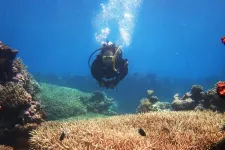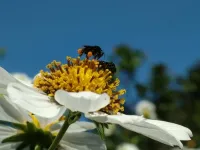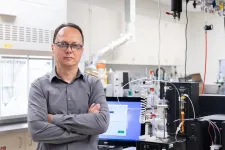A new ‘digital decision support tool’ enabling the transition towards more diversified and sustainable agricultural systems has been developed by an international team of researchers from Germany, France, and Czech Republic.
The research led by Dr Ioanna Mouratiadou from the Leibniz Centre for Agricultural Landscape Research, and published in Environmental Science and Ecotechnology, presents the ‘Digital Agricultural Knowledge and Information System (DAKIS)’ as a data integration framework focused on linking science and strategic decision-making with farm operation and management.
Shift in focus in the agriculture sector
Priorities of the agriculture sector and the broader economy have shifted considerably with time. In the past, the sector’s focus was primarily on delivering agricultural products and services. Now, the focus is increasingly on taking environmental aspects such as ecosystem services, biodiversity, land use, and climate change into account. Renewed policy ambitions at the EU level such as the new Common Agricultural Policy objectives as well as at the global level through the Sustainable Development Goals (SDG2: “End hunger, achieve food security and improved nutrition and promote sustainable agriculture”) further reflect this shift.
The drive to transform agricultural systems to become multifunctional, diversified, and therefore, more sustainable epitomizes this ‘paradigm shift in priorities’. Such ‘new age’ farming focuses on the numerous benefits arising from optimal agricultural decisions and aims to leverage upon the functions of ecological diversity at various spatial scales. Of course, a balance also needs to be struck with other factors across social, economic, and political dimensions that prevail upon land use and agriculture decisions. While sounding promising in theory, putting such comprehensive and considerate farming systems into practice is a considerable task both conceptually and technically.
Digitalization in agriculture has significant potential to address this challenge but gaps remain when it comes to the development and deployment of frameworks, technologies, and tools that integrate large datasets, extract critical analysis from the data, involve citizen science, and translate all of this information into “actionable crop management options”.
The development of DAKIS
In response to the identified challenge(s), authors of this study developed DAKIS as a conceptual framework and also a technologically advanced tool. The study described DAKIS as a “knowledge-based” and “systems-oriented data integration framework that incorporates digital technologies to support highly complex and innovative decision-making”.
DAKIS was developed through a tri-pronged approach of ‘iterative and participatory’ knowledge co-production via extensive stakeholder consultations, review of scientific literature as well as commercial information on 643 digital tools, and a more in-depth critical examination of 42 tools selected for completeness in terms of function and for representing technological state-of-the art. Collectively this process established the aim, spatiotemporal scope, functionality and user interface requirements for DAKIS.
The ‘core functions’ of DAKIS are identified as (i) monitoring production, biodiversity, and ecosystem services, (ii) providing decision support for farm operations, and (iii) supporting communication and collaboration. This conceptual knowledge fed into construction of the DAKIS tool via the ‘design thinking’ approach creating the technical skeleton, delineating different structural components, and interfaces.
To the reader, it is clear that DAKIS has tackled the gargantuan task of synthesizing massive volumes of information collated from remote sensing, in situ monitoring, and GIS mapping data sets, outputs of cross-dimensional economic and environmental effects modelling, and information from participatory impact assessments across diverse farming systems and spatiotemporal scales.
How does this play out in practice? For a moment, imagine yourself as a farmer looking at the Graphical User Interface (GUI) of this tool to set operation preferences and specifying land use objectives. The information provided by you, as the end-user, will be matched against extensive site- and region-specific information available in the platform by a ‘dynamic AI system’ applying a rule-based approach to identify optimal combinations of land use and management. As the end result, you (as the farmer here) will be presented with a range of scenarios and optimal management options for the set objectives and preferences.
The vision of DAKIS is that it “will facilitate/provide site-specific optimization recommendations” enabling end-users to make agricultural decisions to minimize harmful impacts, trade-offs, and conflicts.
Proof-of-concept
DAKIS is currently being tested in two agriculturally diverse regions of Brandenburg and Bavaria in Germany. The publication presents a ‘use case’ – an example of how this tool can be typically used – for establishing grassland buffer patches in Brandenburg. Grassland buffers are landscape elements that provide multiple ecosystem services such as erosion control, carbon sequestration, habitats for pollinators among others.
The Brandenburg use case aimed to determine the optimal design and placement of grassland buffers to maintain agriculture yield while controlling soil erosion better. The selection was informed by DAKIS by analysing remote sensing data to develop an erosion hotspot analysis, assessing multi-annual yield maps, and developing a central criterion that establishment of grasslands must be prioritized on areas with low yield potential and high erosion control potential. An inbuilt system component – the RETE reasoner – then selected optimal locations that fit the criterion. By feeding developed spatially explicit criteria into a series of agroecological, agronomic, and societal demand models, DAKIS compared ecosystem services between current land use versus buffer establishment, selected optimal grass and crop types for each location, and identified locations with greater potential for stakeholder cooperation over conflict.
The final output on the GUI to the farmer was a set of maps and qualitative information recommending best-suited locations and optimal management options for the grassland buffers. Information provided by DAKIS could also be exported to external services such as Farm Management and Information Systems (FMIS) to display and further implement the recommendations.
Uptake of technology and future steps
The study highlights the tremendous potential of digital tools, with spotlight on DAKIS, to transform agriculture and promote more sustainable practices. As the world faces worsening environmental challenges, the use of such technology in agriculture will play increasingly crucial roles in helping build more resilient and sustainable food systems.
“A principal novelty of DAKIS is that it uses digital technologies to enable the consideration of ecosystem services, biodiversity, and sustainability into farmers' decision-making, and providing a decision support system through which farmers are informed and guided towards site-adapted, small-scale, multifunctional, and diversified agriculture along self-defined avenues” as clearly seen in the Brandenburg use case.
The authors write that “In a perfect world, the demand placed by society on the provision of ecosystem services would be satisfied by farmers with the help of DAKIS”, while remarking that in reality such solutions would require strong buy-in(s) from not only farm-level actors but also industries and policymakers. The potential of DAKIS to be useful beyond sub-farm levels – for instance, to policymakers in analysing the effectiveness of agriculture schemes and removing harmful subsidies needs further investigation.
Due to the rapidly developing nature of this field, digital technologies in agriculture will need to become more innovative to keep pace with the speed of new information. With foresight, the developers of DAKIS have already made their framework design adaptable and flexible to incorporate new data connections where needed. While the study mentions “the vision of multifunctional and diversified agriculture can only get adopted if it represents a viable economic alternative to the prevailing agricultural systems”, DAKIS clearly is an important step in the right direction.
END




